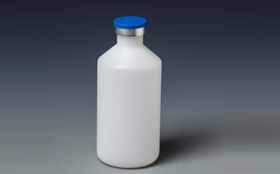Polyethylene bottles are very common in veterinary drug packaging, but polyethylene is generally divided into high-density polyethylene and low-density polyethylene. What is the difference between the two?
Low-density polyethylene (LDPE) is non-toxic, odorless, and odorless, with a density of 0.910~0.940g/cm3. It is polymerized under a high pressure of 100~300MPa with oxygen or organic peroxide as a catalyst. Polyethylene.
Low-density polyethylene is the lightest variety among polyethylene resins. Compared with high-density polyethylene, its crystallinity (55%-65%) and softening point (90-100℃) are lower; it has good flexibility, elongation, transparency, cold resistance and processability; its chemistry Good stability, resistance to acid, alkali and salt solutions; good electrical insulation and air permeability; low water absorption; easy to burn. It is soft in nature, with good extensibility, electrical insulation, chemical stability, processing performance and low temperature resistance (-70℃).
The disadvantage of low-density polyethylene is its poor mechanical strength, moisture barrier, gas barrier and solvent resistance. The molecular structure is not regular enough, the crystallinity (55%-65%) is low, and the crystal melting point (108-126°C) is also low. Its mechanical strength is lower than that of high-density polyethylene, and its impermeability coefficient, heat resistance and solar aging resistance are poor. It is easy to decompose and change color under sunlight or high temperature, resulting in performance degradation.
High-density polyethylene (HDPE) is non-toxic, odorless, and odorless, with a density of 0.940~0.976g/cm3. It is a product of polymerization under low pressure conditions under the catalysis of Ziegler catalyst, so HDPE has also become Low pressure polyethylene.
High-density polyethylene is a non-polar thermoplastic resin with high crystallinity produced by copolymerization of ethylene. The appearance of the original HDPE is milky white, and the thin section is translucent to a certain extent. It has excellent resistance to most domestic and industrial chemicals. It can resist the corrosion and dissolution of strong oxidants (concentrated nitric acid), acid-base salts and organic solvents (carbon tetrachloride). The polymer does not absorb moisture and has good water vapor resistance, and can be used for moisture-proof and anti-seepage purposes.
The disadvantage of high-density polyethylene is that its aging resistance and environmental stress cracking properties are not as good as LDPE, especially thermal oxidation will reduce its performance, so high-density polyethylene is made of plastic coils with antioxidants and ultraviolet Absorbent to improve its shortcomings.

没有评论:
发表评论